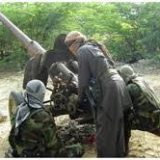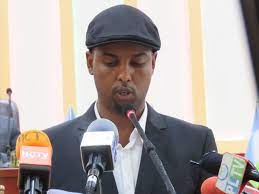Freed Somalia Towns Feel Besieged
Islamist Militants Surround Havens Government Again Controls, Leaving Fearful Residents Isolated, Hungry
HUDUR, Somalia—Women slip into this southern town in the middle of the night with sacks of rice for sale—a lifeline for residents and a move that demonstrates the continued threat from surrounding Islamist militants.
Hudur is one of a number of towns that African Union forces have liberated from al-Shabaab this year only to become isolated government outposts, leaving residents stranded and rebels in control of commercial lifelines.
The troops freed Hudur, a town of some 20,000 about 60 miles from the Ethiopian border, from al-Shabaab militants in March. They were followed by swarms of exiled residents eager to go home. The returnees and a new district commissioner showed how the Somali government was seeking to establish control of the country beyond the fortified capital city of Mogadishu.
But Hudur and many other liberated urban centers now struggle to survive because African peacekeepers—backed by the U.S. and other Western governments—have yet to secure the areas around them. That raises questions about the pace of AU operations.
“Liberating these areas is not a solution necessarily if the entry points and exit points are still blocked,” said Richard Downie, deputy director of the Africa program for Washington’s Center for Strategic and International Studies. “It’s very difficult to hold those areas and provide continued access.”
If the AU troops and the Somali army aren’t able to widen control of rural areas, those towns could easily fall again. These same forces seized control of Hudur in 2012, only to relinquish it to al-Shabaab a year later, forcing government sympathizers to flee.
The risk is that the government will never establish full control, mirroring the situation in the capital, where militants have been pushed out, but have since launched deadly attacks, including one on the presidential palace in July.
“If you’re not careful, Mogadishu is actually the future of the rest of Somalia,” said Stig Hansen, author of “Al-Shabaab in Somalia.” “You have the government in control in the daytime but Shabaab at night.”
The situation in Hudur illustrates the gamble of multiple AU llustrates the gamble of multiple AU offensives to turn the tide in a two-decade-long civil war in Somalia.
There have been clear signs of progress, including the democratic election of a president in 2012 and the U.S. strike this year that killed top al-Shabaab commanders. Since the beginning of the year, AU troops have retaken about 20 towns from militants, disrupting al-Shabaab’s supply lines.
On Sunday, Kenya’s deputy president, William Ruto, said his country’s security forces had killed more than 100 militants and destroyed their camp in Somalia, a day after al-Shabaab claimed responsibility for the ambush of a Nairobi-bound bus that left 28 people dead, Reuters reported.
But military control remains tenuous, and people who make it to freed towns live in fear.
“You liberate, then you consolidate,” said Eloi Yao, a spokesman for the AU force in Somalia.
The Somali army commander for Bakol region, of which Hudur is the capital, said checkpoints tightly control who comes in and out of the town. Anyone who isn’t from Hudur is instructed to call someone in town to vouch for them. Hudur hasn’t had a militant attack since it was retaken, said Col. Abdirahman Mohammed Osman.
“If tonight you stay in Hudur, you will sleep safe,” he said.
Yet those who come can’t leave, for fear of being targeted by al-Shabaab as collaborators. The closest government-controlled town is 50 miles away, and the road is too dangerous to travel without military escorts.
Many in Hudur say they won’t even risk phoning those in nearby villages because of the risk that al-Shabaab militants will discover the communication.
District Commissioner Mohammed Moalim Ahmed —who returned from exile when the town was freed in March—said as people flee to the safety of the town, many residents now house three or four additional families in their compounds. Sanitation and health care are coming under strain.
Modey Ahmed Ali, the man who calls Muslims to pray at a town mosque, said he preferred the government to al-Shabaab—which extracted forced payments from residents—but it has become difficult to buy basics. A kilogram of sugar is about a third more expensive than when the town was controlled by al-Shabaab and grocery store shelves are emptier in general, prompting the dangerous night trips by nearby village women.
The one exception to the food inflation is meat. Hudur had been a livestock-trading hub and now farmers can only make money by butchering their cows and goats.
Commercial trucks or other vehicles only risk traveling to the town when they can tag alongside a military convoy, Col. Osman said. Currently, residents are surviving in large part on food aid. The U.N.’s World Food Program has supplied food to about a third of the town.
The organization was at first only able to airlift nutritional supplies to Hudur, but has now sent two convoys of trucks filled with food—one in September and one this month— after it made the rare decision to travel with armed escorts, said Laila Ali, a spokeswoman for the WFP’s Somalia program. “Without that, basically thousands of people would have been at risk for death from starvation.”
Hudur’s commissioner said the central government has sent little food or financial support for those fleeing al-Shabaab. Only about 60% of the soldiers were getting paid, he said.
Government spokesman Ridwaan Haji Abdiwali confirmed the figure and explained that they were new recruits added after the town was taken. He said salary delays are a problem throughout the government but that they hope to pay the remaining soldiers in Hudur in December.
For now, those in Hudur are trying to stretch the supplies until the next AU convoy arrives, or buying what they can from those sneaking in at night.
Fifty-year-old Idil Salat, who returned to Hudur soon after the government recaptured it, said she had hoped to travel regularly between Hudur and the regional hub of Baidoa, about 80 miles away. She now can’t get anywhere close.
“Going out more than three kilometers,” she said, “is impossible.”
Write to Heidi Vogt at [email protected]
Popular on WSJ




















